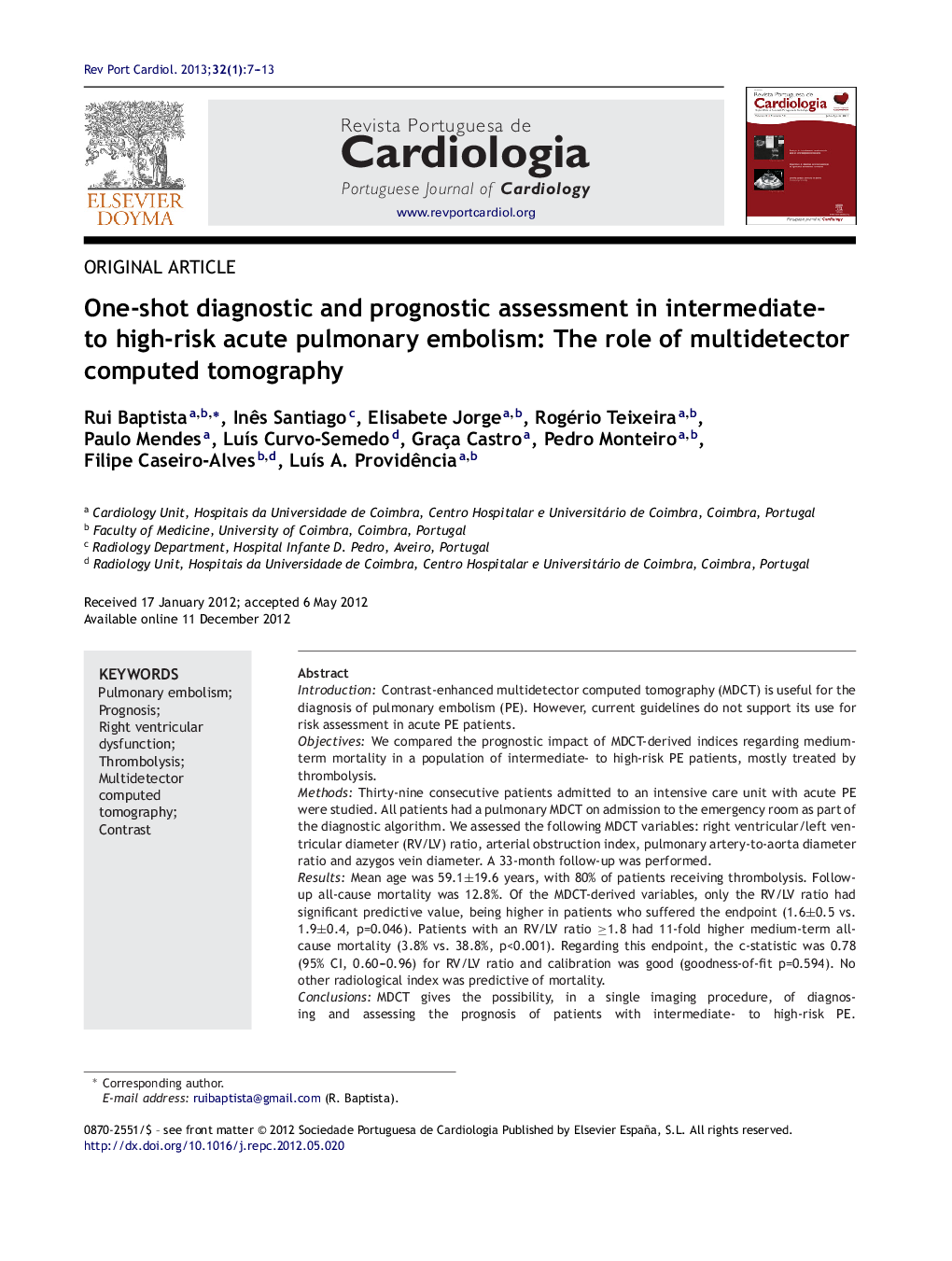| Article ID | Journal | Published Year | Pages | File Type |
|---|---|---|---|---|
| 1126198 | Revista Portuguesa de Cardiologia | 2013 | 7 Pages |
IntroductionContrast-enhanced multidetector computed tomography (MDCT) is useful for the diagnosis of pulmonary embolism (PE). However, current guidelines do not support its use for risk assessment in acute PE patients.ObjectivesWe compared the prognostic impact of MDCT-derived indices regarding medium-term mortality in a population of intermediate- to high-risk PE patients, mostly treated by thrombolysis.MethodsThirty-nine consecutive patients admitted to an intensive care unit with acute PE were studied. All patients had a pulmonary MDCT on admission to the emergency room as part of the diagnostic algorithm. We assessed the following MDCT variables: right ventricular/left ventricular diameter (RV/LV) ratio, arterial obstruction index, pulmonary artery-to-aorta diameter ratio and azygos vein diameter. A 33-month follow-up was performed.ResultsMean age was 59.1±19.6 years, with 80% of patients receiving thrombolysis. Follow-up all-cause mortality was 12.8%. Of the MDCT-derived variables, only the RV/LV ratio had significant predictive value, being higher in patients who suffered the endpoint (1.6±0.5 vs. 1.9±0.4, p=0.046). Patients with an RV/LV ratio ≥1.8 had 11-fold higher medium-term all-cause mortality (3.8% vs. 38.8%, p<0.001). Regarding this endpoint, the c-statistic was 0.78 (95% CI, 0.60–0.96) for RV/LV ratio and calibration was good (goodness-of-fit p=0.594). No other radiological index was predictive of mortality.ConclusionsMDCT gives the possibility, in a single imaging procedure, of diagnosing and assessing the prognosis of patients with intermediate- to high-risk PE. Although further studies are needed, the simple-to-calculate RV/LV ratio has good discrimination and calibration for predicting poorer outcomes in patients with acute PE.
ResumoIntroduçãoA angiografia pulmonar por tomografia computadorizada com contraste (angio-TC) é recomendada para o diagnóstico mas não para a estratificação de risco em doentes com tromboembolia pulmonar (TEP).ObjectivosDeterminar o impacto prognóstico a médio-prazo de vários índices radiológicos obtidos na angio-TC em doentes com TEP de médio a alto risco, a maioria tratados com fibrinólise.MétodosEstudaram-se 39 doentes admitidos numa unidade de cuidados intensivos por TEP, todos com angio-TC prévia realizada na urgência e seguiram-se durante 33 meses. Mediram-se as seguintes variáveis: razão entre os diâmetros do ventrículo direito e ventrículo esquerdo (índice VD/VE), índice de obstrução arterial, razão ente os diâmetros da artéria pulmonar e aorta e diâmetro da veia ázigos.ResultadosA idade média foi de 59,1 ± 19,6 anos; 80% dos doentes foram tratados com fibrinólise. Durante o período de seguimento clínico, a mortalidade foi 12,8%. Das variáveis analisadas, apenas o índice VD/VE demonstrou valor preditivo, sendo significativamente mais elevado nos doentes que faleceram (1,6 ± 0,5 versus 1,9 ± 0,4, p=0,046). Os doentes com um índice VD/VE ≥ 1,8 tiveram uma incidência 11 vezes superior de mortalidade a médio prazo (3,8% versus 38,8%, p < 0,001). Relativamente a este endpoint, o c-statistic foi de 0,78 (95% IC 0,60–0,96) e a calibração elevada (goodness-of-fit p=0,594). Nenhum outro índice radiológico demonstrou associação com a mortalidade.ConclusõesA angio-TC permite num único exame, em doentes de médio e alto risco, diagnosticar e estratificar o risco da TEP. Apesar de serem necessários mais estudos, o índice VD/VE pode identificar doentes com pior prognóstico após uma TEP.
